 French Navy AA destroyers (Built 1951-57, service until 1974-88):
French Navy AA destroyers (Built 1951-57, service until 1974-88):Surcouf, Kersaint, Cassard, Bouvet, Dupetit-Thouars, Chevalier Paul, Maillé-Brézé, Vauquelin, D’Estrées, Du Chayla, Casabianca, Guépratte D621-630
Cold war French Navy:
FS Jean BartFS Arromanches | Bois Belleau class | Clemenceau class | FS Jeanne d'Arc | PA 28 | PH 75 | FS Charles de Gaulle | 2030 PANG
Chateaurenault class | FS De Grasse | FS Colbert
Surcouf class | Duperré class | La Galissonière | Suffren class | Tourville class | Georges Leygues class | Aconit | Cassard Class | Lafayette class | Forbin class | Aquitaine class
La Creole class | Narval class | Arethuse class | Daphne class | Gymnote | Le Redoutable class | Agosta class | Rubis class | Amethyste class | Le Triomphant class
Le Corse class (1952) | Le Normand class (1954) | Cdt Riviere class (1958) | Estiennes D’Orves class (1973) | Floreal class (1990)
Issole | EDIC class | Trieux class | Ouragan class | Champlain class | Bougainville | Foudre class | CDIC class | Mistral class
The first French postwar destroyers:
The T 47 class or Surcouf class were the first destroyers built for the French Navy after the Second World War. Twelve ships were built between 1955 and 1957, heavily modernised and totally rebuilt in the 1960s and ultimately decommissioned in the 1980s, and replaced by the Cassard and Georges Leygues-class frigates. The T47 were authorised in 1949, designed as aircraft carrier escort vessels. Three were modified to become flagships, four became anti-air guided missile destroyers during their career and five ASW destroyers. One survived, Maillé-Brézé, now as a museum ship at Nantes. Their importance in the French Navy could not be understated, by their numbers and longevity they provided the bulk of the French destroyer force for most of the cold war.
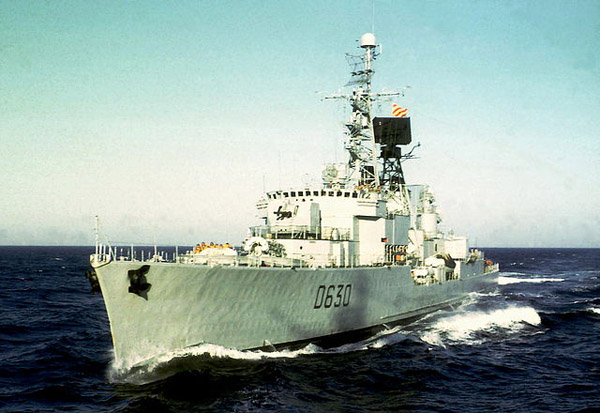
The Du Chayla after refit in the late 1970s
Genesis of French postwar destroyers
These destroyers were larger than other contemporary destroyers in Europe, but still, were based on a WW2 design, the Hardi class, but much enlarged and integrated dual purpose armament to integrate lessons learned with late war allied destroyers, notably those of the Gearing class. The basic design, drawn from early studies in 1948-49 were aimed at creating a Squadron escort, or “Escorteur d’escadre” in French. They were not meant for independent operations, and had a slower speed than previous designs, a trademark of earlier French destroyers. Their standard displacement was still considerable at 2,750 long tons (2,794 t), up to 3,740 long tons (3,800 t), fully loaded for 128.6 metres overall. This situated them between the Le Fantasque and Mogador class “super destroyers”. Technically they were of course conventional, as no alternative design as possible for the time. Antiship missiles were still in their infancy, at least in Europe.
The T47 were ordered to four different yards. Most went from Arsenal de Lorient (Surcouf, Kersaint, Bouvet, Maillé Brezé, Vauquelin), AC Bretagne (Cassard, Casabianca), Arsenal de Best (Dupetit-Thouars, d’Estrees, Du Chayla) and FC de la Gironde, Bordeaux (Chevalier Paul, Guépratte). The names mostly referred to ancient famous Marine officers, mostly from the XVII-XIXth Centuries.
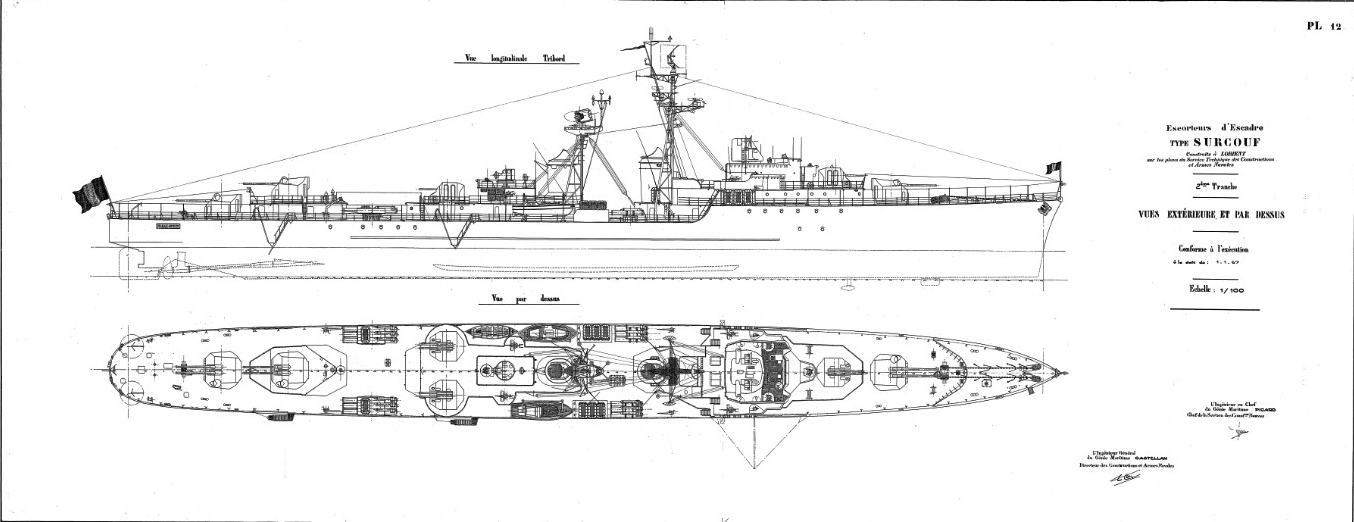
Blueprint of the class in its first design, 1949.
Powerplant
The powerplant was conventional, using Rateau geared turbines, on two shafts, and with four boilers working at 500 pounds per square inch (3,400 kPa), they produced a total rating of of 63,000 shaft horsepower. This allowed a top speed of 34 knots (63 km/h; 39 mph) which was still honorable, and consumption still authorized a range of 5,000 nautical miles (9,300 km; 5,800 mi) at 18 knots (33 km/h; 21 mph) thanks to 700 long tons (710 t) of fuel oil aboard, compared to 2,900 nmi at 15 knots for The “Fantasque” but more of less equivalent to the larger Mogador.
Armament
The class was initially designed for fleet anti-aircraft warfare, and as other ship’s class of the time drawing lessons from WW2, their main guns were dual-purpose.
5-in M1948 (127 mm)
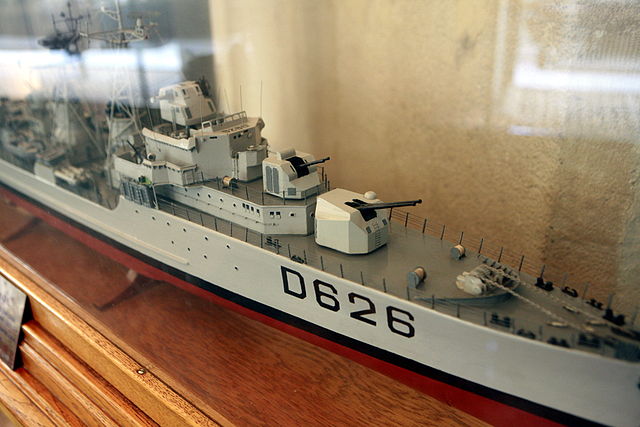
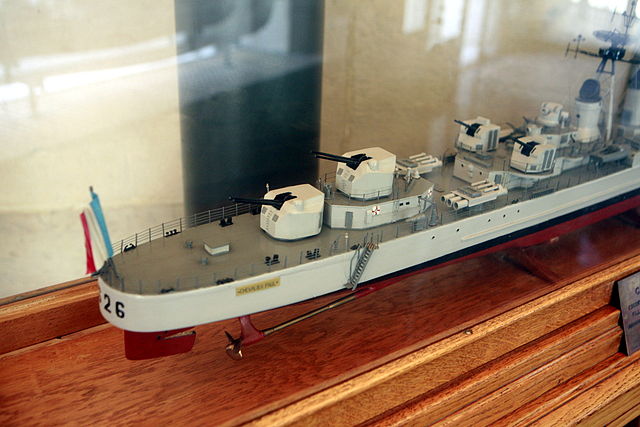
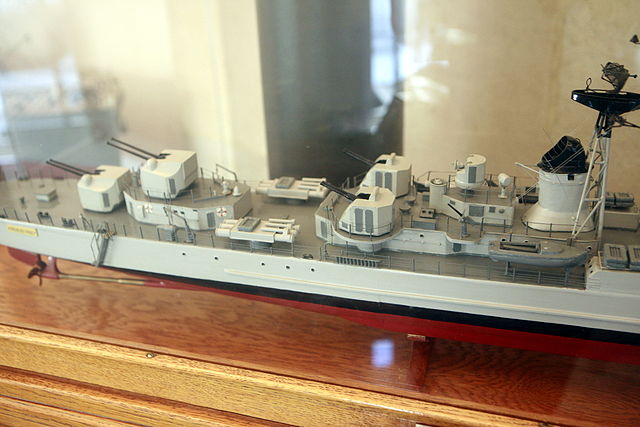
Three views from the shipyard model showing the armament of the T47 class.
These were the Model 1948, 5 inches (127 mm)/54 guns which used the same standard U.S. ammunition present across the board within NATO. This main armament was placed in three twin turrets, like the Sumner and Gearing classes. This was the standard major-caliber AAA weapon of the Marine Nationale in the early cold war, shared by cruisers and destroyers. A completely new design taking advantage of the massive stockpile of US 5-in ammunition. It was also the first high-angle mounting use on French vessels and essentially a dual-purpose development of the prewar twin 130mm mounting (Le Hardi class). However it was not automated, with 11 personnel per gun, so ‘heavy and over-complex’ as described at the time. It failed to meet its requirements for the rate of fire (15rpm per gun) and was heavily modified before and after entering service. It was superseded by the single 100 mm which became the new standard, until the end of the cold war. There will be a detail outlook during a future upgrade of the French cold war navy page. More.
2.2-in M1951 (57 mm)
The secondary armament comprised three twin 57mm/60 guns modele 1951. Called also 57 mm/60 (2.25″) SAK Model 1950 in Sweden and 57 mm/60 (2.25″) Modèle 1951 in France. Indeed, it was orignally a new Bofors water-cooled design, used by Netherlands, France and Sweden. Bofors introduced this weapon a scaled-up version of the highly successful 40 mm/70 Model 1948. Unlike the latter, the four-round clip (main critic of the operations) was dropped, since the much larger ammunition would have made the clips way too heavy. Loaders were asked to drop individual rounds into ammunition boxes, feeding in turn quadrant-shaped hoppers mounted at the gun’s trunnions, working by gravity at all angles. After reviewing weapons in 1946, the French Navy Conseil Superieur decided the 40 mm Bofors was now inadequate against upcoming jets and decided to adopt the Bofors 57 mm AA gun. They were mated to a French-designed twin turret, ending on the Jean Bart and T47 destroyers. Still, their effectiveness against jets was questionable. More on these on navweaps.com
Light AA
The light AA armament was still very much influenced by WW2 and comprised four single-mounted 20 mm Oerlikon cannon, but no 40 mm Bofors. It was believed the 57 mm guns took their role in the close-to-medium range defence. This emphasis on AA armament reflected a complete U-turn in the French admiralty compared to WW2, now centered around aircraft carrier protection. France acquired
indeed the Arromanches in 1946 (purchased 1951), Lafayette and Bois Belleau in 1950. Of course in 1957, the first local large carriers were built, the Clemenceau class, while the T47 were still in construction: The last four were commissioned in 1957.
ASW/AAW armament
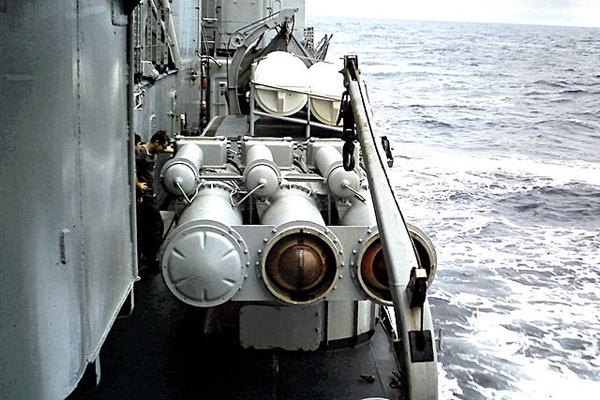
L3 Torpedo launch banks. These acoustic ASW torpedoes were larger, but shorter than standard 21-in models.
Originally, the ships were pure AA escorts, with little to no anti-submarine warfare armament. There were still the basic depth charge racks and a sonar. The design however included a single quadruple 550 mm (21.7 in) torpedo tubes bank for AAW. It was mounted between the aft 127 mm and 57 mm gun mounts, and allowed some close range antiship defense. However the design was modified and it was changed to four triple banks, same caliber but carrying more variety of torpedoes for AAW/ASW warfare. Two were placed the each broadside and the forward pair was modified to fire the L3 ASW homing torpedoes while the aft pair could fire either the L3 torpedoes or the K2 anti-ship torpedoes. Indeed, the French considered the Hedgehog and Squid but preferred to stick with the torpedo formula, which arguably was less complex and space-consuming. This will change with the mid-life refits.
The L3 was an electric acoustic-homing anti-submarine torpedo designed in the 1950s and in service in 1960. About 600 has been manufactured. Powered by a Nickel-cadmium Battery, they carried a warhead of 440 lbs. (200 kg) with Tolite A1, and can reach 5,500 yards (5,000 m) at 25 knots. The K2 (1956) was essentially similar to the American Weapon Alfa, British Limbo and Italian Menon, but using a torpedo body rather than a rocket. It was made for speed, powered by an Oxygen-alcohol turbine, carrying a 617 lbs. (280 kg) HBX-3 or TNT warhead at 1,000 yards (900 m) at 50 knots.
Electronics
At the origin, the T47 carried French sonars DUBV 1 and DUBA 1 mounted on the hull. There were considerations to adopt British-pattern lattice mast, but a compromise was found, twin tripods with lattice to carry a DRBV 11 surface/air search radar. These were completed by DRBV 20A and DRBC 11 and DRBC 30 radars installed partly on the other tripod in front of the aft funnel. The main armament direction was was managed by a single FCS at the front, placed over the bridge as in earlier designs. A second one was installed aft for the 57 mm guns, on a raised platform behind the aft funnel.
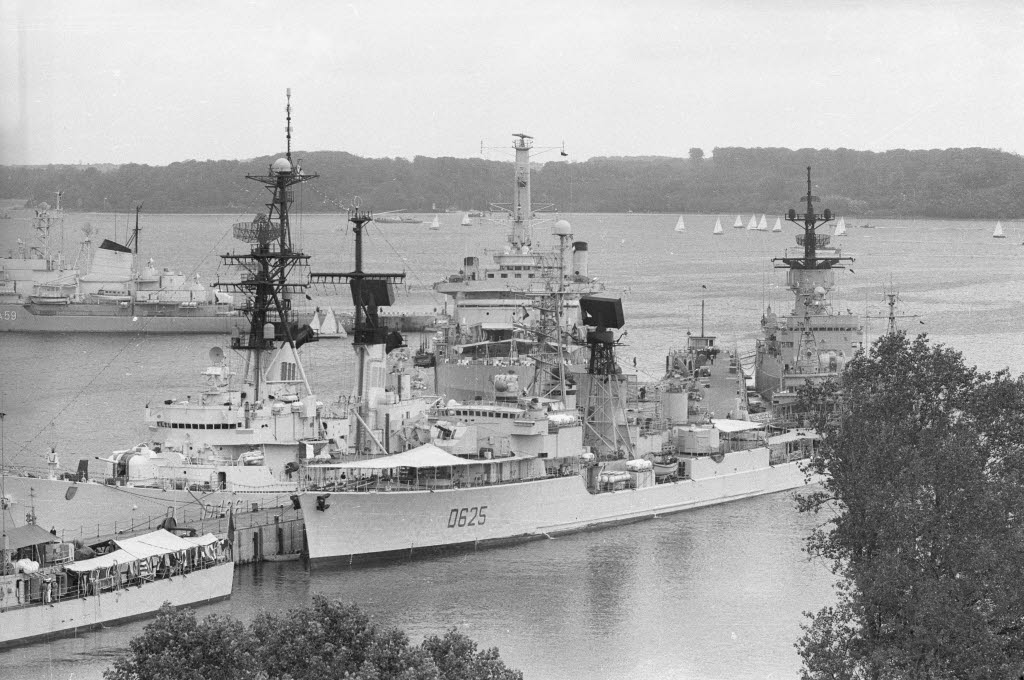
1960 modernizations
During the 1960s the entire class were comprehensively modernised and divided into three specialized classes, AA (missile) and AAW/ASW and others as flotilla flagships.
Flotilla Flagships:
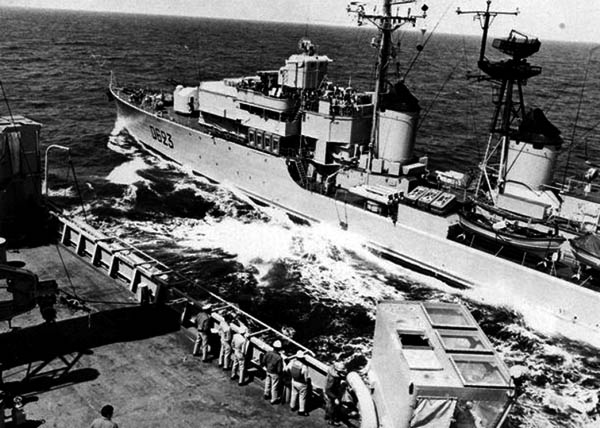
Cassard refuelling from USS Savannah on 1974 (USN photo)
These modifications concerned the Surcouf, Cassard, and Chevalier Paul. Called “conducteurs de flottilles” they were rebuilt between 1960 and 1962. After this conversion they lost one 57 mm gun turret, two triple torpedo launchers and two 20 mm AA guns. This was in order to enlarge the superstructure and accommodate the admiral bridge and staff, plus additional long-range communications equipment (later upgraded for satellite communication). They were designed as replacements for two light cruisers acting as such, but recently withdrawn from service. In 1962, Cassard was fitted with a flight deck to carry an helicopter.
AAW Destroyers
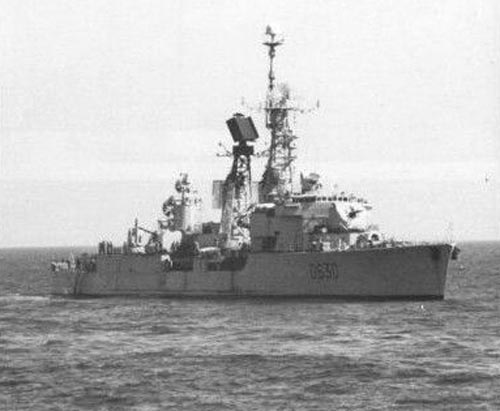
Du Chayla in 1991
This major reconstruction concerned four ships: Bouvet, Kersaint, Dupetit-Thouars and Du Chayla – They became anti-aircraft guided missile destroyers. The reconstruction took place in 1962–1965.
Armament:
Their main weapon system was the US-provided Tartar missile launcher placed aft with a new superstructure for the reloading system and stores, and SPG-51 tracker-illuminators, but they retained their three twin 57 mm AA turrets. The other important addition was a single sextuple 375 mm (15 in) Model 1972 ASW mortar. The new aft raised deckhouse was installed between the aft 57 mm guns and housed the complete reload chain, down to the missile store. The Model 1972 mortar replaced the forward 127 mm turret and the main artillery fire control director was removed. They all kept their forward set of torpedo tubes.
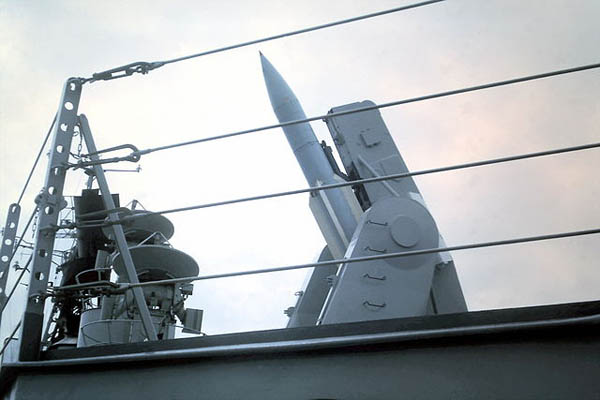
Tartar mark 13 on the T-47 destroyers
Electronics:
This sub-class received an upgraded DRBC 31 radar, moved to the fire control director’s former spot, atop the bridge. The DRBV 11 radar was removed and replaced by the US SPS-39A 3D and later B model. Complement was down to 278, 17 officers, 261 ratings. In the late 1970s, these ships also received the SENIT 2 action information centre, housed in a reworked bridge superstructure aft. In 1979, Dupetit-Thouars and Du Chayla received the new air search radar DRBV 22.
ASW Destroyers
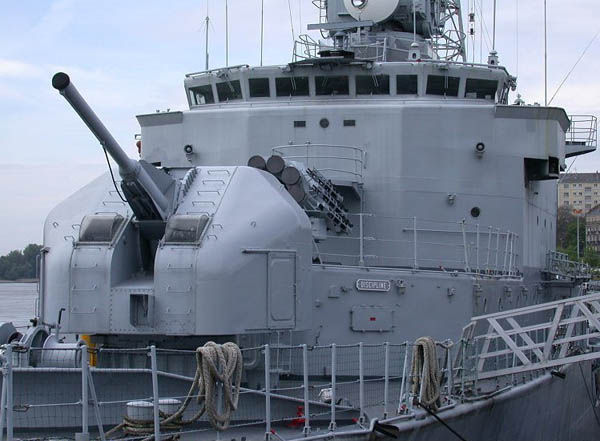
The bridge as Maillé Brezé as rebuilt (now a museum ship)
This was the last reconstruction programme for the T47, and the most radical. It concerned the conversion of D’Estrées, Maillé-Brézé, Vauquelin, Casabianca and Guépratte as specialized ASW destroyers. This took place in 1968–1970. D’Estrées was a trial vessel, inaugurating a variable depth sonar, already tested before reconstruction in the early 1960s.
Armament:
As rebuilt, they had now:
-Two Mod 53 DP 100 mm (4 in) guns, one forward and one aft, controlled by a DRBC 32A fire control director.
-One 375 mm sextuple ASWR (anti-submarine rocket launcher) Modele 1972 forward, behind the 100 mm on a raised deck on “B” position.
-A Malafon anti-submarine missile launcher. The Malafon was comparable to the US ASROC and similar systems. It was installed aft, with the magazine directly in front of it. More on this on the future upgraded French Navy cold war weapons section.
-Two 20 mm Oerlikon guns for close defense.
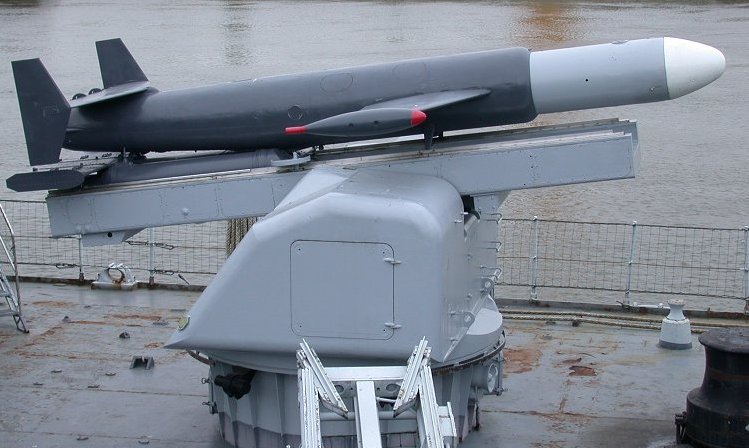
Malafon ASWM on Maillé Brezé
Electronics:
Their DRBV 22A air search radar was mounted atop the tripod mast and the DRBV 50 air/surface radar was located below it on its own advanced platform. They all carried the DUBV 23 and DUBV 43 sonars which needed a reconfigured bow. This also required them to have a new clipper bow, and a stern anchor. Overall length went to to 132.5 metres (434 ft 9 in) and complement was reduced to 260 due to greater automation.

Maillé Brezé 1971

Dupetit-Thouars 1972
T47 class destroyers (as designed) |
|
| Dimensions | 128.62 x 12.7 x 5.4 m (422.0 x 42 x 18 ft) |
| Displacement | 2,750 t standard, 3,740 tons FL |
| Propulsion | 2 shafts Parsons geared steam turbines, 4 fuel boilers |
| Performances | 63,000 shp (47,000 kW), 34 kts (63 km/h; 39 mph), range 5,000 nmi (9,300 km)/18 kts |
| Armament | 3×2 127, 3×2 57, 4 × 20 mm AA, 4×3 550 mm TTs |
| Crew | 347 |
More resources
Sites:
//forummarine.forumactif.com/t8972-escorteurs-d-escadre-t47
//www.navweaps.com/Weapons/WTFR_Main.php
//en.wikipedia.org/wiki/Malafon
http://www.netmarine.net/f/armes/lr375/index.htm
http://www.netmarine.net/bat/ee/surcouf/caracter.htm
http://www.netmarine.net/bat/ee/surcouf/index.htm
http://www.netmarine.net/bat/ee/kersaint/index.htm
http://www.netmarine.net/bat/ee/cassard/index.htm
http://www.netmarine.net/bat/ee/bouvet/index.htm
http://www.netmarine.net/bat/ee/dupetit/index.htm
http://www.netmarine.net/bat/ee/chevalie/index.htm
http://www.netmarine.net/bat/ee/maillebr/index.htm
http://www.netmarine.net/bat/ee/vauqueli/index.htm
http://www.netmarine.net/bat/ee/destree/index.htm
http://www.netmarine.net/bat/ee/duchayla/index.htm
http://www.netmarine.net/bat/ee/casabian/index.htm
http://www.netmarine.net/bat/ee/guepratte/index.htm
http://www.shipspotting.com/gallery/photo.php?lid=1331951
https://fr.wikipedia.org/wiki/Classe_T_47
https://www.seaforces.org/marint/French-Navy/Destroyer-Frigate/Surcouf-class.htm
https://www.battleships-cruisers.co.uk/surcouf_class.htm
https://www.worldnavalships.com/surcouf_class.htm
https://commons.wikimedia.org/wiki/Category:Kersaint_(D622)
https://en.wikipedia.org/wiki/T_47-class_destroyer
https://www.meretmarine.com/fr/content/maille-breze-le-dernier-escorteur-descadre
Document: Profiles of all destroyers and their evolution over time (pdf)
Photos of the Maillé Brezé as museum ship
Books
J. Gardiner, Conway’s all the world’s fighting ships 1947-1995
Blackman, Raymond V. B., ed. (1953). Jane’s Fighting Ships 1953–54. London: Sampson, Low and Marston.
Gardiner, Robert; Chumbley, Stephen & Budzbon, Przemysław, eds. (1995). Conway’s All the World’s Fighting Ships 1947–1995. Annapolis, Maryland: Naval Institute Press.
Jordan, John (2020). “T47 Surcouf”. In Jordan, John (ed.). Warship 2020. Oxford, UK: Osprey.
Moore, John, ed. (1974). Jane’s Fighting Ships 1974–75. New York: Franklin Watts Incorporated.
Jean Moulin, L’escorteur d’escadre Maillé Brézé, Rennes, Marines Editions, jan. 2010
Jean Meyer, Martine Acerra: Histoire de la marine française des origines à nos jours, Rennes, Ouest-France, 1994
Michel Vergé-Franceschi, Dictionnaire d’Histoire maritime, Paris, éditions Robert Laffont 2002
Alain Boulaire, La Marine française : De la Royale de Richelieu aux missions d’aujourd’hui, Quimper, éditions Palantines, 2011
Rémi Monaque, Une histoire de la marine de guerre française, Paris, éditions Perrin, 2016
Videos
The model kits corner
The great classic: 1/350 Heller 81013 SURCOUF French Destroyer
Model by l’arsenal 1/700
The T47 in service
The destroyers would have been completely obsolete in 1960 so they were the object of a large modernization programs making them “specialists”. The less upgraded were those of the first serie, and understandably they left service sooner: Surcouf and Chevalier Paul in 1971, cassard in 1974 and the remainder in the 1980s. None, apart Maillé Brezé, saw the end of the cold war. The latter became a museum ship at Nantes.
 Surcouf (D-621)
Surcouf (D-621)

She was commissioned in November 1955, based in Toulon, First Destroyers Flotilla and heading the Fourth Destroyer Division (DEE4). In 1956, she took part in naval exercises notably with including NATO’s MEDCOM and coastal surveillance off Algeria. By October-December 1956 she took part in Operation Musketeer as part of the landings in the Suez Crisis.
On 10 April 1959, she was attached to the Tenth Destroyer Division (DEE10), Light Fleet at Brest. On 26 March 1960, she collided with the cargo Léognan off Groix. The damage needed long repairs.
In the early 1960s, she was converted as a command ship and flotilla leader. Her forward 57 mm mount was removed and her bridge extending forward, as well as her two aft torpedo banks and new housing quarters built. This tok place in drydock at arsenal of Brest, from 11 June 1960 to 4 October 1961 after she completed post-refit sea trials. She was then assigned to the main fleet in Toulon, as admiral flagship, 1st FEE (ALFEE). In March 1962, at the Battle of Bab El Oued (OAS coup in Algeria), she shelled OAS troops holding Bab el-Oued quarter, Algiers, together with Maillé-Brézé. However the bombardment was called off as giving few results and massive collateral damage. The destroyers kept their station as a deterrent until the coup was over. Both ships would later ferry troops from France to Algiers on 2 March, fighting the OAS rebellion.
On 6 June 1971, 60 nautical miles (110 km) southeast of Cartagena, Spain, Surcouf was underway with the tactical group led by the aircraft carrier Arromanches, when she collided, rammed by the bow of the Soviet tanker General Busharov, six times heavier than the destroyer. The impact ocurred at 16 knots (30 km/h; 18 mph), almost cutting Surcouf in half. Nine men were lost during the impact. Surcouf was later assisted by the French destroyer Tartu of the same same tactical group, which attempted to tow her out, when she snapped in two, the bow sinking quickly. The aft part however still had buoyancy, and was taken in tow to Toulon, via Cartagena. What was left of her was sunk as target by Exocet missiles off Toulon after being decommissioned on 5 May 1972.
 Kersaint (D-622)
Kersaint (D-622)

Kersaint underway in 1963
Second of the T47/T51 serie of 18 destroyer escorts, Kersaint was designed as an AA/ASW escort, laid down in Lorient in June 1951, launched in October 1953 and in service by March 1956. The eary part of her career alternated between fleet exercizes with the fleet and NATO. Until 1963 she served at her home base in Toulon, visiting most ports of the Mediterranean, but made longer trips, in the Atlantic as well. In 1956 for example she stopped in Brest, Bône, Philippeville, Monaco, Izmir, Smyrne, Rhodes, Crete, Gibraltar, Casablanca, Dakar, Conakry, Bizerte, Haïfa while in 1957 she visited Bizerte, Dakar, Simonstown, The Cape, Diego Suarez, Djibouti, Tamatave, Réunion, Lourenço Marquez, Abidjan, Dakar, Brest, Plymouth and Alger.
She participated also in the Suez operations of October 1956, firing 65 shell on an unknown ship, later identified as the Egyptian destroyer Ibrahim el Awal (disabled and later boarded by the Israeli Navy). She had two major overhauls during her active life, the first from February 1964 to April 1965, called the “Tartar” overhaul, with this weapons system installed with reloading houising, magazing and fire control directos ans assoviated radars. The second was performed from December 1970 to June 1972. After her conversion she was based in Brest, Atlantic squadron. She escorted the task forces of Foch and Clemenceau when active in the Atlantic.
She was active for the last time on March 3, 1984, condemned on May 23, 1985, and mothballed as hull number Q638. Instead of being sold for BU she was used as a target in May 1986, sunk during an exercise with the Escadre de l’Atlantique.
 Cassard (D-623)
Cassard (D-623)
Laid down at Ateliers et Chantiers de Bretagne, Nantes, in November 1951, launched in May 1953 she was in service in April 1956. She was rebuilt in the early 1960s, modified as flotilla leader and command vessel, like his sisterships Surcouf and Chevalier Paul. Cassard took part in the Suez Canal crisis in November 1956, shortly after her return in active service on May 7, 1962, together with Georges Leygues and Bouvet. She stayed in reserve for a possible sortie of Egyptian vessels and shelling on demand. Afterwards, she returned to her home base in Toulon, until the end of her career.
As a flotilla leader she acted as flagship of the Third Flotilla of fast escorts (3rd FER). With the reorganization of the naval forces on September 15, 1965, she hoisted the mark of the admiral commanding the Mediterranean Escort Flotilla (ALFLOMED3). On November 1, 1969, she became flagship, Mediterranean squadron, replacing Colbert lefing for Brest and transformation as a missile cruiser from November 19691. Cassard spent the rest of the 1960s and early 1970s participating in NATO exercizes and was decommissioned on October 1, 1974, but remaining in special reserve until June 1, 1976. She was written off from service, removed from list and was mothballed as the hull Q555 hull. She later served as a breakwater in the Anse du Fret, between Île Longue and Rostellec (Britanny), and later moored on a safe in the Landévennec ship cemetery. She left for Spain on August 14, 1989 to be BU.
Bouvet (D-624)
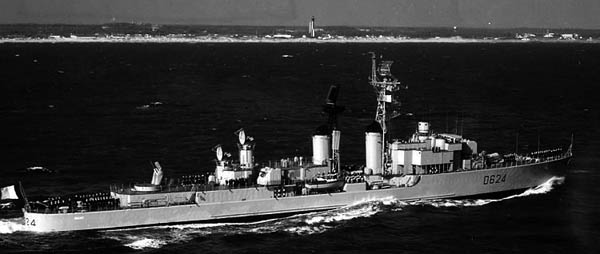
The Bouvet after her Tartar refit, seen from an US Navy plane, Norfolk, 1965
The Fourth in the T47/T51 serie she was designed as an AA/ASW escort, laid down in Lorient (Lanester basin) in November 1951, launched in October 1953, and in service by May 1956. Just admitted in active service, she participated in the Algerian war, shelling shore objectives in the region of Nemours (June 5 and 10, 1956), and went on with on demand fire support for a battalion of the 2e REP, south-west of Bougaroni on June 29, 1956. The same year, she was involved in the “Suez affair” by November 1956 with Georges Leygues, Cassard and Dupetit-Thouars, for escort for the French task force of Operation Musketeer. She was modernized in 1964 as a missile destroyer, her main armament being now the Tartar surface/air missile on a single Mk 13 ramp. From the on she was based in Brest, Atlantic Sqn, multiplying exercizes with NATO atlantic command. Her first Atlantic trip took place before conversion in 1963 rallying Cherbourg to head for Fort-de-France, and Pointe-à-Pitre (French Caribbean), and on the American north coast, Saint Pierre island, Québec, Chicago, Montréal, and back to Royan, French Atlantic coast. After refit, she visited Ponta Delgada, Norfolk, Mayport, San Juan, de Porto Rico, Yorktown, New-York, Montréal, Chicago, and Detroit. In 1970 she underwent her second refit, with new electronic and command systems SENIT. She was based in the Mediterranean squadron again. In 1973 she visited Lisbonne, Lagos, Gand, La Horta, Ponta Delgada, Porto Rico, Jacksonville, New-York, Saint Malo, and La Spezia. She carried out also four missions in the Indian Ocean in 1974-1975, 1977, 1979 and 1980.
She was decommissioned on January 1, 1982, mothballed as hull number Q635. She served as a breakwater in Lorient, but left on September 21, 2012, to be towed to Ghent in Belgium, sold to shipbreaker Van Heygen Recycling yards, a subsidiary of Galloo group.
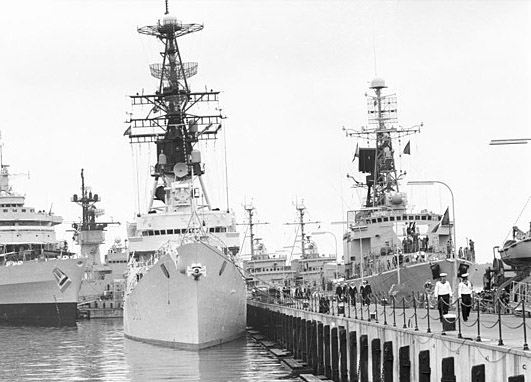
Bouvet at Kiel navy week, 1971
 Dupetit-Thouars (D-625)
Dupetit-Thouars (D-625)

Fifth in the T17 serie, Dupetit-Thouars was laid down in Brest, March 1951, launched in February 1954, and in service by September 1956. She took part in the Suez crisis of November 1956, shortly after entering service, teaming with Georges Leygues, Cassard and Bouvet. She was based in Toulon, taking part in NATO exercizes, Mediterranean command, until her Tartar refit in 1962. In 1957 she made her first transatlantic trip, visiting Oran, Alger, Fort-de-France (Martinique, French Caribbean), Norfolk, Philadelphia, adnd back to the med, Casablanca, Malte, Bizerte, Bône, and Marseille. In 1963, she visited Punta Delgada, Norfolk, Mayport, San Juan de Porto Rico, Yorktown, and Washington and made a North sea/Baltic trip in 1964, visiting Hamburg, Copenhague, Haugesund, Arendal, Oslo, and Amsterdam. She took part in seven missions in the Indian Ocean, and one off Lebanon, Exercize Olifant XVII. In 1973 she had her SENIT refit.
During her career, Dupetit-Thouars covered 753,000 miles. She was decommissioned in April 1988, hull number Q662. Since then, she is a breakwater at Lanvéoc (Britanny), in front of the Marine Naval School. Dupetit-Thouars was sponsored by the Foreign Legion.
 Chevalier Paul (D-626)
Chevalier Paul (D-626)

A shipyard model of D626 Chevalier Paul
Sixth T47 squadron escort, Chevalier Paul was laid down at the Forges et Chantiers de la Gironde, February 1952, launched in July 1953 and in service by December 1956. She was based in the Mediterranean, visiting in 1956 Copenhague, Oslo, Narvik, Reykjavik, Ponta Delgada and in 1957 Fort-de-France (French Carib.), Hampton Road, Philadelphia, Casablanca, Brest, Cherbourg, Portsmouth, Malte, and Bizerte. In 1961 she was based in Brest and was rebuilt as a flotilla leader like Surcouf and Cassard, with new accomodation for the admiral and his staff. In 1963 she visited Portsmouth, Fort-de-France, Basse Terre, Key West, Halifax, Montréal, Invergodon, and Rosyth and in 1964 Copenhague, Vikser, Hangesund, Kristiansund, Oslo, Amsterdam, Portsmouth, Le Havre, and the was present in the armada at the D-Day beaches of Normandy during the 20th anniversay celebrations. In 1970 she made a round trip, stopping at Chatham, Dakar, Pointe Noire, Capetown, Diego-Suarez, Colombo, Port Swettenham in Malaisia, Singapore, Bangkok, Madras, Durban, Abidjan, and Las Palmas.
Decommissioned in June 1971, hull number Q537, she became a breakwater at Saint Mandrier (Var, French Rivera) from 1978 to 1979, and was later sunk off Toulon as a target by Super Etendards from the aircraft carrier Clemenceau. The previous ship bearing this name was a large destroyer (1930 to 1941) and today, a Horizon class frigate. Chevalier Paul (born 1598) was a commoner, and a bastard, which rose in the ranks of the French Navy to become an admiral under Richelieu, distinguished himself in the Mediterranean an died in 1667.
 Maillé Brezé (D-627)
Maillé Brezé (D-627)
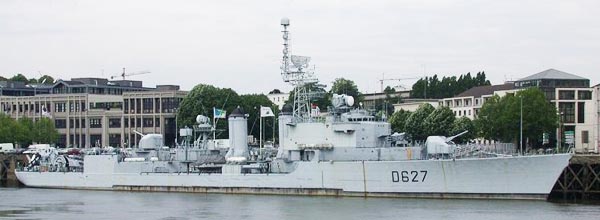
Maillé Brézé as a museum ship today in Nantes.
Maillé-Brézé was initially intended as an anti-aircraft escort, but modified as an ASW escort. She was laid down in Lorient on October 9, 1953, launched on July 2, 1955, and admitted into active service on May 4, 1957, sponsored by the city of Saumur. Her missions spanned ten years, including rotation in the Atlantic and Mediterranean, undergoing significant activity and fleet exercizes with NATO. In 1957 she visited Bergen, Bodø, Tromsø, Hammerfest, Oslo, Hamburg, Gibraltar, Palma de Mallorca, Bizerte, Lebanon, Algiers, Oran, Mers el-Kébir, Arzew, Bastia and in 1958 Bône, Bougie, Arzew, Malta, Palermo, Sciacca, and Naples. In January 1967-August 1968, she was completely overhauled, reconstructed and fitted with new modern detection and ASW weapons systems, notably the Malafon missile and a very characteristic towed sonar. By then she supported the Strategic Oceanic Force (FOST).
After a long and active career she was eventually decommissioned on April 1, 1988, renamed Q661. Handed over to the “Nantes Marine Tradition” association, she became a naval museum, refitted as such, and opened on July 1, 19881. She was classified later as an historical monument since October 28, 1991, benefiting from state funding for her maintenance.
Her second career as a museum ship did not stopped there: In September 2015, she took part in the “Teenage Kicks” urban art festival, and painted on the river side of the hull, gangway, funnels and gun as temporary artwork by two artists, Velvet and Zoer4, inspired by the Razzle Dazzle.
Also between May and June 2016, she was used as a prop by movie director Christopher Nolan during the filming of “Dunkirk” (Operation Dynamo) and to be shot as a French ww2 destroyer, certain modern elements were dismantled. She was towed to Saint-Nazaire for fitting-out work during 7 days, after which she returned to Dunkirk and the filiming with all costs covered by Warner Bros.
 Vauquelin (D-628)
Vauquelin (D-628)
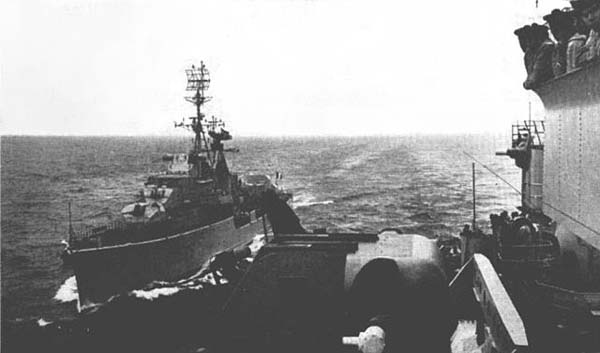
Vauquelin in 1957
The eighth in the T47 serie, Vauquelin was at first an AA before, redesigned as ASW escort. She was laid down in Lorient, Lanester basin, on March 8, 1954, launched on September 26, 1954, and admitted to active service on November 3, 1956. She took part in the Suez operations in 1956, patrolled the coast of North Africa during the Algerian war. In 1957 she made her first long trip,, stopping at Cannes, Villefranche, Dakar, Simonstown, Le Cap, Diego Suarez, Djibouti, Aden, Majunga, Tuléar, Lourenço Marquez, Abidjan, Brest, and Plymouth. She was refitted in 1968-69 and in the early 1970s, joined the Atlantic squadron. Her missions were from then on to support the new French nuclear missile launching submarines of the FOST operating from Brest, Long island, and protected commercial navigation roads. In 1978 she made one of her longest cruise, stopping at Santa Cruz de Tenerife, Dakar, Abidjan, Freetown, Recife, Belem, Fort-de-France , Pointe-a-Pitre, Saint Barthélemy, Port au Prince, Miami, Norfolk, Boston, Halifax, Saint Pierre et Miquelon, Saint Jean de Terre Neuve, Toulon, and Plymouth.
Until the end of her career she covered 664,272 miles in 2000 days at sea.
She was decommissioned on November 6, 1986, hull number Q654 in April 1987. She was used in 1988-2001, as a target for missile tests for the benefit of the DGA. She was hit notably by the marine Crotale NG missile. From 2001 she was used as a breakwater in Toulon. She was sunk on February 13, 2004 by a Super-Etendard strike from Charles de Gaulle.
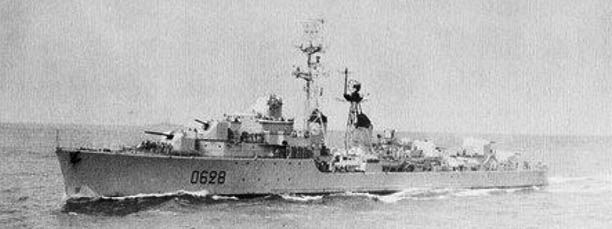
Vauquelin in 1962
 D’Estrée (D-629)
D’Estrée (D-629)
She was the ninth in the T47 serie, designed as AA escort before and redesigned as ASW escort. She was laid down on October 6, 1953, in Brest, Laninon basin, launched on November 27, 1954 same day as her sisters ship Du Chayla, and admitted to active service on March 19, 1957. She served with the Med squadron, Toulon. In 1959-1961, she tested a landing platform for a Marine Alouette III light helicopter with floats. On November 9, 1961, she was damaged following a collision with her sister ship Tartu. She had a first great drydock maintenance in 1962. She was rebuilt in 1966 in Brest, but returned to Toulon. In 1975 she made one of her largest cruise, stopping at Malaga, Naples, Patras, Djibouti, Singapour, Bangkok, Belawan, Colombo, La Réunion, and Augusta. In 1982 she patrolled off Larnaca during the Lebanon civil war. Her career saw her covering 422,000 miles.
On July 3, 1985, D’Estrées was decommissioned, hull Q642 by December 1985. She was used as a breakwater at Saint Mandrier, but was sunk on September 12, 2001 off Toulon by a F17mod2 torpedo from the nuclear attack submarine Saphir.
 Du Chayla (D-630)
Du Chayla (D-630)

Du Chayla in 1991.
The Tenth in the T47 serie, Du Chayla was later rebuilt as a missile destroyer and squadron escort. Laid down in Brest, Laninon basin, in July 1953, she launched on November 1954 and admitted to active service in June 1957. She spent his entire career at Brest Naval Base, with the Atlantic squadron. In 1961 she made one of her longest cruise, visiting Mers el Kébir, Alger, Arzew, Cadix, Le Havre, Cherbourg, Bordeaux, Bergen, Stockolm, Karlskrona, Gdynia, Dunkerque, Ponta Delgada, Norfolk, Yorktown, Key West, Port au Prince, La Guayra, Fort-de-France, La Désirade, Les Saintes, Pointe-à-Pitre, and Dakar. On July 4, 1973, she collided with the fast escort Le Corse, cutting her bow clean out. She was repaired and was back in service. In 1977 she made her first trip in the Indian Ocean, after visiting Cherbourg Portland, Santander, Augusta, Djibouti, she stopped in Colombo, Mayotte, and Port des Galets.
In 1984, she was in Brest’s functional rehabilitation center. Du Chayla covered 913,860 miles during her career. She participated in the 1990-91 Gulf war, covering 30,700 nm and visiting 100 ports. The last flag hoisting ceremony took place on November 15, 1991. She served as a breakwater at Ile Longue (Brest, SSBN base), she was sunk in September 2001 off Brittany, testing a 80 kgs depth charge, which broke her in two. She is now an artificial reef for marine life.
 Casabianca (D-631)
Casabianca (D-631)
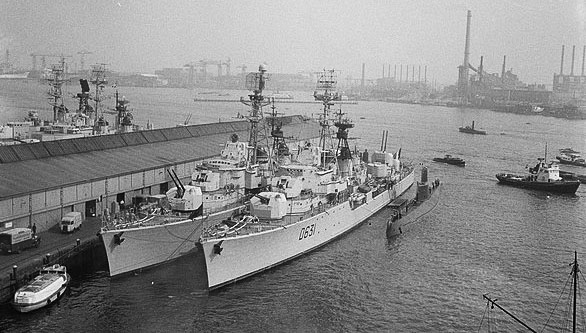
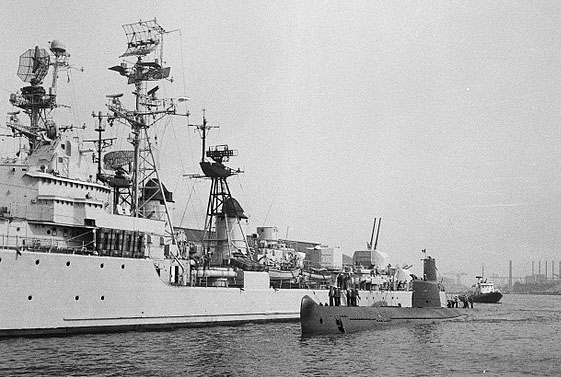
Casabianca in Amsterdam, 1964
The eleventh in the T47 serie, Casabianca was later redesigned and rebuilt as an ASW destroyer, like Maillé Brezé. Shhe was laid down at the Forges et Chantiers de la Gironde (Bordeaux, former Dyle & Bacalan yards) in October 1953, launched on November 13, 1954, and in active service by May 4, 1957. She made her first trainig cruiser in 1956, visiting Hambourg, Kiel, Bergen, and Plymouth. She was based in Brest for all her carrer, hunting Soviet submarines. She underwent a major overhaul (notably with the Malafon missile) in Brest arsenal, from January 1968 to January 1969. She was decommissioned on September 7, 1984, hull Q639 in May 1985 and part of her aft deck hydraulic system (MSR2C) towed sonar was mounted on the aviso Commandant Rivière for experiments. Casabianca was named after the Corsican Marine officer under Louis XIV Luc Casabianca, which notably served under De Grasse, taking part in the battles of Fort-Royal (29 april 1781), Chesapeake (5 september) and Saint-Christophe (jan. 1782). For this reason, the destroyer was sponsored by the city of Bastia. Her name was of a former, famous French submarine which served witn the FNFL in WW2, and again given to a moden SSN.
 Guépratte (D-632)
Guépratte (D-632)
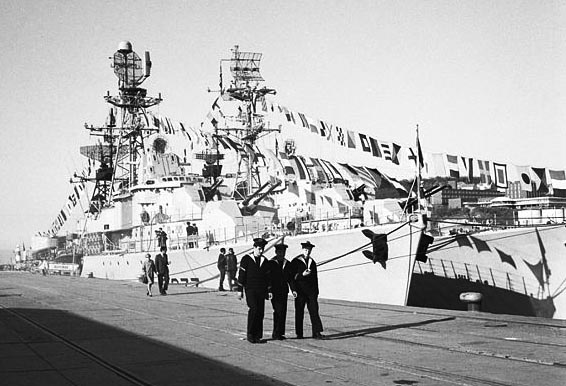
Guépratte and Duperré in Trondheim, 1965
The last in the T47 serie, Guépratte was designed was later rebuilt as an anti-submarine destroyer escort. She was laid down at the Ateliers et Chantiers de Bretagne, Nantes in August 1953, launched on November 8, 1954, and in service on June 6, 1957. Her shakedown training cruise in 1956 took her to Morgat, Swansea, Royan, Granville, Brest, Toulon, Ponta Delgada and the next year she visited Brest, Tanger, Toulon (which became her homebase), Cherbourg, Portsmouth, and Bizerte. In 1961, she made her longest trip, bringing her to Cadix, Plymouth, Cherbourg, Bordeaux, Bergen, Copenhague, Thorhavn, Nemours, Ponta Delgada, Norfolk, Yorktown, Key West, Port au Prince, various Atlantic islands and Dakar.
On December 14, 1966, the Naval Missile Testing Group (“Group M”) was formed, working for the benefit of the Landes Test Center, studying ballistic missiles. Guépratte was used as lead ship for a squadron comprising also Le Savoyard and Le Basque and the 24th minesweeper division. She was rebuilt into an anti-submarine destroyer at Brest arsenal from August 1968 to August 1970.
On may 12, 1981 a Soviet SSN of the Victor class was spotted 50 nautical miles in front of Toulon, while tracking the aircraft carrier Clemenceau. Guepratte, Georges-Leygues and several Atlantic maritime patrol planes plus Lynx ASW helicopters started to hunt her down. She tried everything to throw off its pursuers, stopping dead and pushing at 30 knots, to try to deceive French sonars, but after 18 hours of this, she was forced to surface and left the area.
Guépratte was disarmed on August 5, 1985. By then, she covered 640,000 miles in 2,600 days at sea. She became hull number Q643 on March 13, 1986, sunk on November 9, 1994 by two Exocet missiles AM39 launched by a maritime patrol aircraft of 23F flotilla and a Super-Etendard.

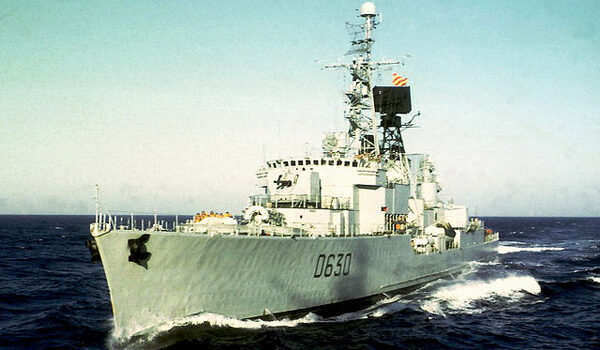

 Latest Facebook Entry -
Latest Facebook Entry -  X(Tweeter) Naval Encyclopedia's deck archive
X(Tweeter) Naval Encyclopedia's deck archive Instagram (@navalencyc)
Instagram (@navalencyc)





 French Navy
French Navy Royal Navy
Royal Navy Russian Navy
Russian Navy Armada Espanola
Armada Espanola Austrian Navy
Austrian Navy K.u.K. Kriegsmarine
K.u.K. Kriegsmarine Dansk Marine
Dansk Marine Nautiko Hellenon
Nautiko Hellenon Koninklije Marine 1870
Koninklije Marine 1870 Marinha do Brasil
Marinha do Brasil Osmanlı Donanması
Osmanlı Donanması Marina Do Peru
Marina Do Peru Marinha do Portugal
Marinha do Portugal Regia Marina 1870
Regia Marina 1870 Nihhon Kaigun 1870
Nihhon Kaigun 1870 Preußische Marine 1870
Preußische Marine 1870 Russkiy Flot 1870
Russkiy Flot 1870 Svenska marinen
Svenska marinen Søværnet
Søværnet Union Navy
Union Navy Confederate Navy
Confederate Navy Armada de Argentina
Armada de Argentina Imperial Chinese Navy
Imperial Chinese Navy Marinha do Portugal
Marinha do Portugal Mexico
Mexico Kaiserliche Marine
Kaiserliche Marine 1898 US Navy
1898 US Navy Sovietskiy Flot
Sovietskiy Flot Royal Canadian Navy
Royal Canadian Navy Royal Australian Navy
Royal Australian Navy RNZN Fleet
RNZN Fleet Chinese Navy 1937
Chinese Navy 1937 Kriegsmarine
Kriegsmarine Chilean Navy
Chilean Navy Danish Navy
Danish Navy Finnish Navy
Finnish Navy Hellenic Navy
Hellenic Navy Polish Navy
Polish Navy Romanian Navy
Romanian Navy Turkish Navy
Turkish Navy Royal Yugoslav Navy
Royal Yugoslav Navy Royal Thai Navy
Royal Thai Navy Minor Navies
Minor Navies Albania
Albania Austria
Austria Belgium
Belgium Columbia
Columbia Costa Rica
Costa Rica Cuba
Cuba Czechoslovakia
Czechoslovakia Dominican Republic
Dominican Republic Haiti
Haiti Hungary
Hungary Honduras
Honduras Estonia
Estonia Iceland
Iceland Eire
Eire Equador
Equador Iran
Iran Iraq
Iraq Latvia
Latvia Liberia
Liberia Lithuania
Lithuania Mandchukuo
Mandchukuo Morocco
Morocco Nicaragua
Nicaragua Persia
Persia San Salvador
San Salvador Sarawak
Sarawak Uruguay
Uruguay Venezuela
Venezuela Zanzibar
Zanzibar Warsaw Pact Navies
Warsaw Pact Navies Bulgaria
Bulgaria Hungary
Hungary

 Bundesmarine
Bundesmarine Dutch Navy
Dutch Navy Hellenic Navy
Hellenic Navy Marina Militare
Marina Militare Yugoslav Navy
Yugoslav Navy Chinese Navy
Chinese Navy Indian Navy
Indian Navy Indonesian Navy
Indonesian Navy JMSDF
JMSDF North Korean Navy
North Korean Navy Pakistani Navy
Pakistani Navy Philippines Navy
Philippines Navy ROKN
ROKN Rep. of Singapore Navy
Rep. of Singapore Navy Taiwanese Navy
Taiwanese Navy IDF Navy
IDF Navy Saudi Navy
Saudi Navy Royal New Zealand Navy
Royal New Zealand Navy Egyptian Navy
Egyptian Navy South African Navy
South African Navy






























 Ukrainian Navy
Ukrainian Navy dbodesign
dbodesign